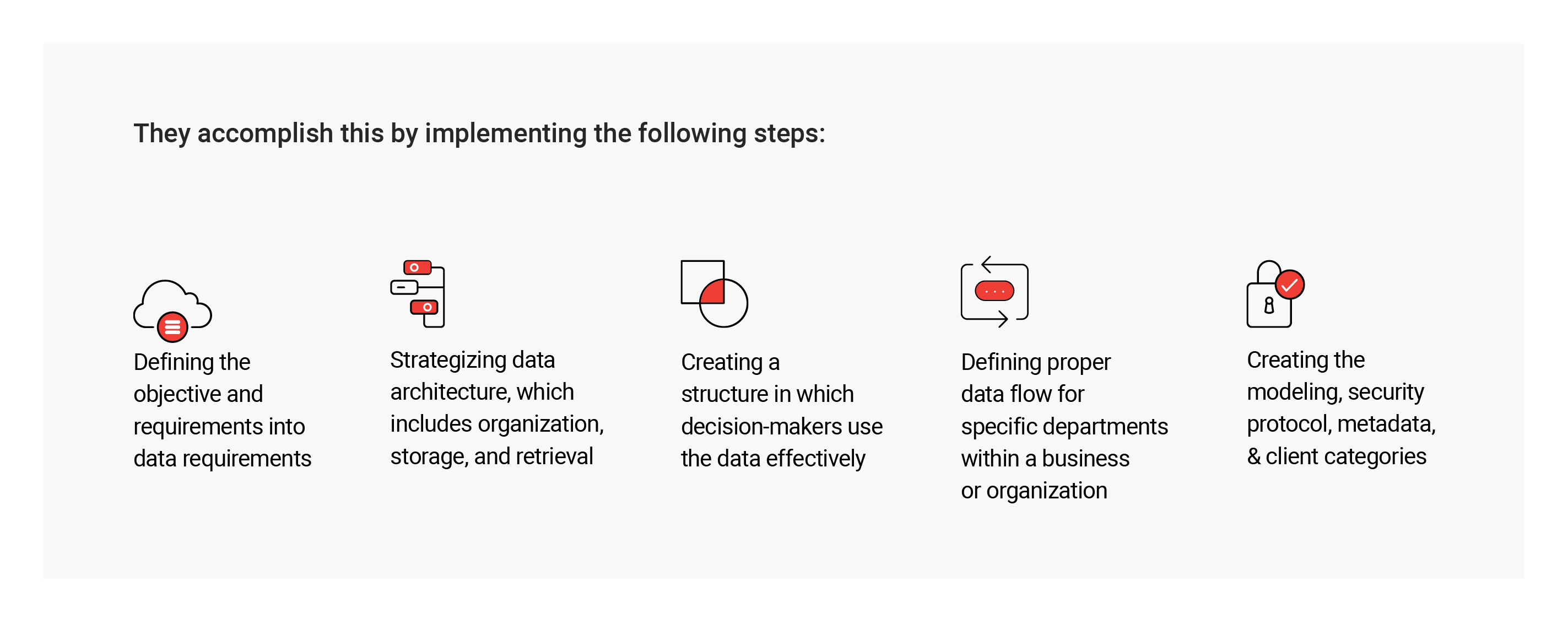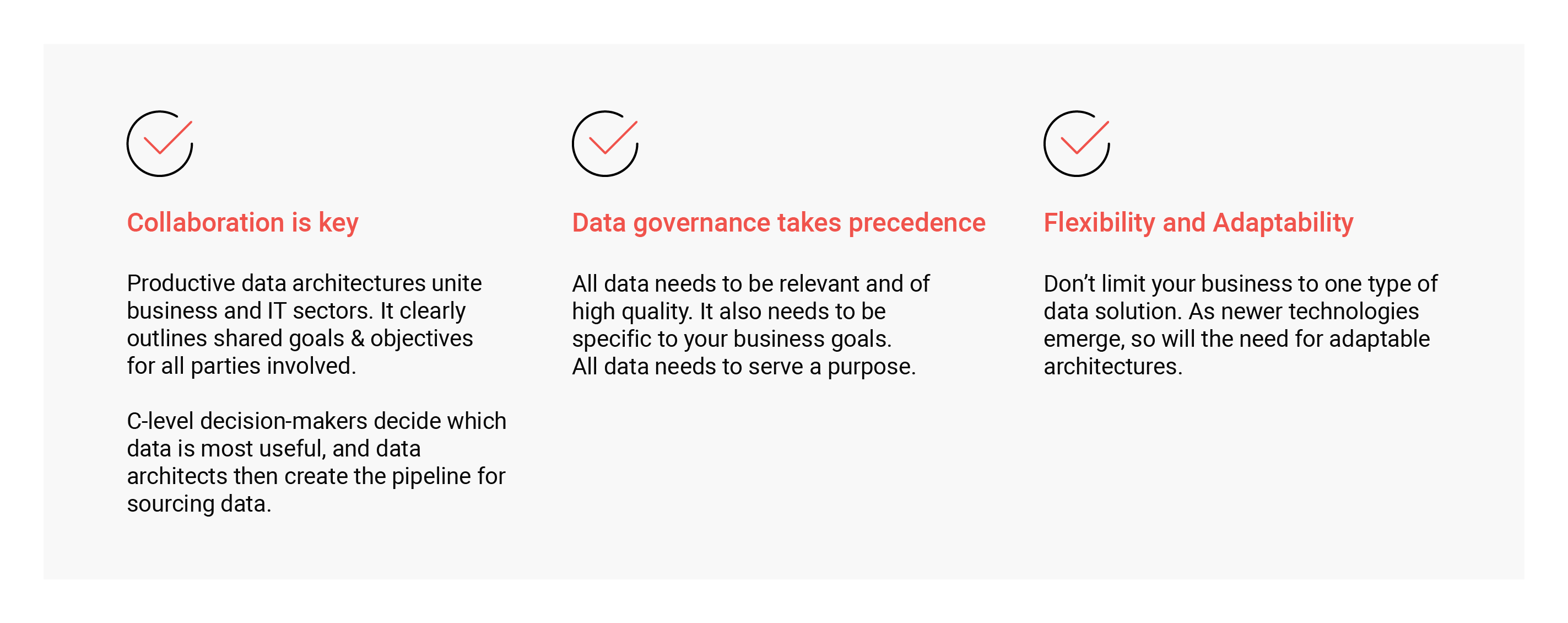Modern Data Architecture
From helping businesses make educated decisions to reducing operating costs, big data really is a big deal.
But why?
As technology continues to evolve, so does the need for insight into customer behavior and market trends. Even though most businesses are using big data, not everyone knows how to use it effectively.
To make the most out of data and analytics, you need to understand how modern data architecture operates and the reasoning behind it.
In this guide, we’ll dig deeper into big data and discuss the role of a data architect. We’ll also discuss how modern data architecture can bring your business into the future.
What is Big Data?
Big data is large volumes of data, both structured and unstructured, which businesses are inundated with every day.
But it’s not just the type or sheer amount of data that’s important; it’s how it’s used to make strategic business decisions.
What is Data Architecture?
In only a few short years, businesses shifted from traditional data mining and storage to more streamlined methods.
That’s where data architecture comes in.
Businesses that operate on modern data can anticipate future needs of consumers. They use this information to review emerging market trends and optimize their marketing strategies.
Organizations that fail to upgrade to modern data architecture ultimately lose customers and reduce their market share.
In simplest terms, data architecture defines the tools a business utilizes to analyze and manage data.
Modern data architecture takes things a step further.
Modern data architectures are platforms that bridge the gap between decision-makers and IT professionals.
With modern data architecture, the processes used to capture and deliver important data within the business are also an integral part.
More importantly, modern data architecture outlines how the parties will consume the data and how it’s delivered.
What is Data Architect?
Similar to architects who design residential homes, data architects create blueprints for specific data flows and processes.
The blueprints are based on the objectives within a business or organization. More specifically, they’re visionaries who design the framework for enterprise data and its management.
A data architect works closely with internal stakeholders, alongside external vendors, to create a data strategy that helps businesses make data-driven decisions.

Data architects also work to define reference architectures, which serve as guides for team members to expand current data systems.
Pillars of Successful Data Architecture
Well-designed modern data architecture always flows from right to left; specifically, from the data consumer to the data source.
Previously, data architectures were data warehouses. And because of their initial design and technology used, managing them was a time-consuming process.
Unfortunately, the gap between requests for data and final delivery often resulted in revenue loss or missed opportunities.
While modern data architecture still delivers usable data to a warehouse, it’s more agile and adaptable. It can change and evolve in response to the user’s needs.
With that said, there are basic components to modern data architecture that define its framework:
- User-centric. As mentioned above, the focus is now on the user and their needs. Users can be either internal or external stakeholders. Their needs may vary depending on their department or role. Data architects can now collect and deliver requested data to meet the user’s objectives.
- Adaptive. In modern data architectures, data flows from the source to the user. Successful data architecture always encourages collaboration.
It combines data from all parts of the business, in addition to external sources, into one specific place. Within this structure, data is seen as a shared asset.
- Scalability. One of the most important pillars of modern data architecture is its scalability. Unlike traditional limitations seen in data lakes or databases, newer data architectures are faster and are easily accessible on the cloud.
- Automation. Automating processes using cloud-based tools slashes production time. Processes that once took months to create are now built in just a few hours.
- Intelligence. In conjunction with automation, machine learning and AI are the foundation of modern data architecture.
AI can swiftly identify and correct errors in data reporting, create structures for new data and advise on incoming data with in-depth analytics.
- Elasticity. Scalability is only part of the puzzle. When it comes to modern data architecture, being able to roll back or scale on-demand is even more important. Elasticity gives administrators the power to shrink or scale without limitation.
- Security. Security features are built into the data architecture to limit who has access to it. Well-designed architectures are aware of both current and emerging security threats. They’re also GDPR and HIPAA compliant.
How Data Architecture and the Cloud Work Together
Even though it seems like cloud computing is relatively new, theoretically, it’s been around for 40 years.
But with such an accelerated shift to a more cloud-based model, it’s important to understand how data architecture and the cloud work together.
With rapidly changing demands of data, businesses need scalable or elastic architectures at their disposable.
Thankfully, the cloud allows for rapid scalability, which is a cost-effective solution. It’s especially useful in cases of on-demand development as well as prototyping.
The cloud is also resilient. It can process large amounts of big data quickly in real-time. According to Gartner Research, enterprise data spending will account for approximately 15% of global spending on IT by 2024.
It’s also estimated that over 70% of businesses and organizations currently using the cloud are also planning on increasing cloud spend when they expand their modern data architecture.
Modern Data Architecture and Your Business
The main goal of data architecture is to streamline the way businesses gather, store, distribute and ultimately use data.
Another important goal is to provide valuable data to the right people within the business or organization.
Not so long ago, when specific data was needed, a request was made, and IT would find a way to deliver it in a timely manner.
This typically involved hours of manpower prior to delivery. In turn, this type of architecture made it difficult to access the right information when necessary.
Modern data architecture breaks the barrier between strategists and IT.
It enhances collaboration, communication, workflow, and productivity. Businesses can determine which data is most useful, the best way to source it and how to distribute it to the right internal stakeholders.
Data Fabric and Architecture
In today’s digital landscape, change is inevitable. Businesses that consider data a strategic asset will be better equipped to navigate that change.
But to stay one step ahead, businesses and organizations alike need to use data fabrics to guarantee unlimited access to all their data sources.
Let’s break it down.
Every business needs to use data analytics to its fullest potential. To streamline the process, you also need data agility.
Data agility connects and then combines the data from various sources for review.
Data fabrics house the connections between all the data, regardless of type or where it comes from.
They can also tell you what the data does, and how it relates to other relevant data. Without data fabrics, your ability to use data analytics to its fullest potential might be limited.
Data Architecture Strategies
Similar to marketing, you need to have a solid strategy when developing your data architectures.
Here are a few things to keep in mind:

Information and Data Architectures
It’s also important to understand the difference between information and data architectures. Data architecture is about sourcing, collecting, and using available data.
Informational architectures are more about using the data that’s collected to make strategic business decisions.
The Takeaway
For businesses that embrace modern data architecture, the future has never been brighter. But as traditional methods of data collection, storage, and disbursement fade into the background, the need for meeting customer demands will only continue to grow.
At TVS Next, we help clients harness the power of AI and data assets. And as technology and data analytics continue to expand, businesses that use the power of modern data architecture will have an edge over those that don’t.










